| Pieter de Hooch | |
|---|---|
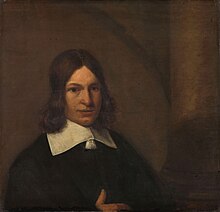 Possible self-portrait (1648–1649?) Possible self-portrait (1648–1649?) | |
| Born | Pieter Hendricksz. de Hooch before (1629-12-20)20 December 1629 Rotterdam, Dutch Republic |
| Died | after 1683 (aged at least 54) |
| Nationality | Dutch |
| Education | Nicolaes Berchem |
| Known for | Painting |
| Movement | Dutch Golden Age Baroque Delft School |
| Spouse |
Jannetje van der Burch
(m. 1654; died 1667) |
| Children | 7, including Pieter Pietersz. de Hooch |
| Signature | |
Pieter Hendricksz. de Hooch (Dutch: [ˈpitər ˈɦɛndrɪksoːn də ˈɦoːx]; also spelled Hoogh or Hooghe; bapt. 20 December 1629 – after 1683), was a Dutch Golden Age painter famous for his genre works of quiet domestic scenes with an open doorway. He was a contemporary, in the Delft Guild of St. Luke, of Jan Vermeer with whom his work shares themes and style. De Hooch was first recorded in Delft on 5 August 1652, when he and another painter, Hendrick van der Burgh witnessed the signing of a will. He was active in 1683, but his date of death is unknown (his son Pieter died in 1684, a date often wrongly given for the father).
Biography
De Hooch was born in Rotterdam to Hendrick Hendricksz de Hooch, a bricklayer, and Annetge Pieters, a midwife, baptised at the Reformed Church in Rotterdam in 1629. He was the eldest of five children and outlived all of his siblings, evidently raised in a working class home. Though, his father was described as a "master bricklayer", hence a skilled artisan required to be a member of the guild. Little is known of his early life, and most archival evidence suggests he worked in Rotterdam, Delft, and Amsterdam. According to his first biographer Arnold Houbraken, he studied art in Haarlem under the landscape painter Nicolaes Berchem at the same time as Jacob Ochtervelt and was known for his "kamergezichten" or "room-views" with ladies and gentlemen in conversation. But de Hooch's work seems to continue in the spirit of Hendrik Sorgh, an older Rotterdam painter who had a special affinity for organising figures in interiors.
Beginning in 1650, he worked as a painter and servant for a linen-merchant and art collector named Justus de la Grange in Rotterdam. His service for the merchant required him to accompany him on his travels to The Hague, Leiden, and Delft, to which he moved in 1652, settling on Oude Delft 161 with de la Grange. Later, he lived next to the former Saint Hieronymus convent, once situated between Oude Delft and Westvest. It is likely that de Hooch handed over most of his works to la Grange during this period in exchange for board and other benefits, as this was a common commercial arrangement for painters at the time, and a later inventory recorded that la Grange possessed eleven of his paintings.
De Hooch was married in Delft in 1654 to Jannetje van der Burch, possibly sister of Hendrick van der Burgh, by whom he fathered seven children. While in Delft, de Hooch is also believed to have learned from the painters Carel Fabritius and Nicolaes Maes, who were early members of the Delft School. He became a member of the painters' guild of Saint Luke in 1655 (two years after Vermeer). Though, he must have faced financial difficulties, as he was unable to pay the admission fee of 12 guilders. His daughter Anna was born in Delft on 14 November 1656. Based on the fact that his wife attended a baptism in Amsterdam in 1660, it has been determined that he moved to Amsterdam by then, though the success of the trekschuit by then meant that a trip to Amsterdam could be made easily in a day.
Little is known of de Hooch's living arrangements in Amsterdam, though it has been established that he had contact with Emanuel de Witte through a lawsuit brought against de Witte. The burial records in Amsterdam for two of de Hooch's children, dated June 1663 and March 1665, indicate that he resided on Regulierspad and Engelspad, respectively. These "paths" were situated outside the old city walls and were known for accommodating some of the city's poorest inhabitants, sharply contrasting his affluent clients in Amsterdam. In 1668, he was living in the Konijnenstraat near the Lauriergracht, where he stayed for the next two years at least. His third son was baptized in 1672. In 1674, de Hooch's financial situation was meagre enough to escape the tax registers entirely, likely a result of the declining art market in the Dutch Republic, following the onerous Rampjaar, which hugely strained the economy and all facets of Dutch cultural activity. In his later years, de Hooch painted more, and often larger paintings, measuring over 100 centimetres.
The date of his death is unknown. For a significant period, it was believed that de Hooch died in 1684 as a resident in the Amsterdam dolhuis, a lunatic asylum. Despite this, official records from that institution reveal that the Pieter de Hooch who died there was, in fact, the artist's son, who also bore the name Pieter. The registration of his son Pieter Pietersz. de Hooch at the Dolhuis in 1679 is noted as the last record of de Hooch in Amsterdam.
In 2017 the Turing Foundation sponsored a new research project for the Delft Prinsenhof museum and the Rijksmuseum to work on a new overview exhibition focussing on the works in their collection, to be presented in a combined exhibition 2019–2020.
Works
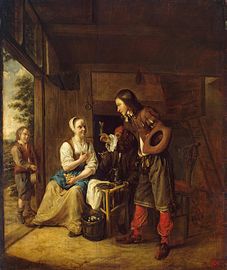
The early work of de Hooch was mostly composed of scenes of soldiers and peasants in stables and taverns in the manner of Adriaen van Ostade, though he used these to develop great skill in light, colour, and perspective rather than to explore an interest in the subject matter. In these merry company compositions, the focal point is not dispersed among numerous figure groups, in contrast to the soldier paintings of other artists. Instead, emphasis is concentrated on a principal group illuminated directly by the sun, which prominently stands out against a dark background, in the style of chiaroscuro. These works frequently showcase colour combinations typical of the artist's later period, such as a vivid vermilion and lemon yellow, often complemented by a warm dark green or blue in the shadows. Occasionally, backgrounds open into brightly lit adjoining rooms, and lighted figures may be framed in doorways, known as a 'doorsien', literally a 'see through'. The contrast between light and shadow tends to be accentuated, with sunlit portions of the canvas appearing cooler and paler compared to his later works. Notably, De Hooch's mastery is most evident when portraying figures in repose, exemplified in two masterpieces painted around 1654 - one housed in the Palazzo Corsini and the other in the London National Gallery - which mark the culmination of his early period.
Delft Period 1652-1660
De Hooch's early artistic development is evidenced by the maturity exhibited in his paintings executed around 1655. By 1654, he had attained a zenith in depicting soldier scenes, a focus that persisted into the initial years of his marriage. After starting his family in the mid-1650s, he switched his focus to domestic scenes. These were possibly of his own family, though his works of well-to-do women breastfeeding and caring for children could also indicate that he had attended his mother on her rounds as a midwife. Evidence also suggests that de Hooch may have been employed as a servant under Justus de la Grange, an experience which likely influenced his empathetic and nuanced portrayal of servants and domestic workers in his paintings. His work showed astute observation of the mundane details of everyday life while also functioning as well-ordered morality tales. From the fact he dated a whole series in 1658, whilst he dated very few others, suggests he himself recognised the importance of these paintings.

These paintings often exhibited a sophisticated and delicate treatment of light similar to those of Vermeer, who lived in Delft at the same time as de Hooch. The themes and compositions are also comparable between De Hooch and Vermeer. 19th-century art historians had assumed that Vermeer had been influenced by de Hooch's work, and indeed de Hooch first demonstrated a special interest in combining the figure with interior geometry. He succeeded in blending the South Holland techniques of perspective and interior space construction with powerful naturalism and focus on figures, a style undoubtedly influenced by the prominent genre painters of his time. An x-ray of Woman Weighing Gold Coin shows that De Hooch had first tried to paint another figure in the empty chair, pointing to his canvas being the more original model that Vermeer quoted. Another signature work of Vermeer, The Love Letter, is also said to have been inspired by de Hooch, and paintings of Vermeer have been found to have posthumously been inscribed with the signature of de Hooch, perhaps in attempt to inflate the value of the then unknown Vermeer's paintings.

In the late 1650s, Pieter de Hooch pioneered a new genre of painting that showcased unprecedented spatial order and naturalism. In tranquil depictions of homes and courtyards, which appear casually observed and informal, are carefully composed with a sophisticated grasp of perspective and a fine attention to aerial accuracy. Many of these subtly revolutionary paintings revisit themes from his early works, such as merry companies with drinking soldiers, accompanied by their hostesses. However, the dimly lit stables and taverns of his earlier period are replaced by sunlit interiors, gardens, and courtyards of the middle class. De Hooch's cityscapes were some of the last Dutch painting specialties to emerge. Along with Fabritius' A View of Delft, Pieter de Hooch's depictions of courtyards, bleaching grounds, and street scenes often feature prominent genre figures and are notable for their early focus on urban environments. These works are among the first to emphasise cityscapes, cropping up mainly in de Hooch's time in Delft, where his works feature important buildings such as the Oude Kerk, Nieuwe Kerk, and the rooftop of the newly built Amsterdam Town Hall. Also featured are areas of residence for de Hooch, including courtyards similar to those found behind old Delft homes around the Binnenwatersloot where his wife lived. These edifices were often arranged fictitiously, bringing many important buildings into one scene. De Hooch also shared themes and compositions with Emanuel de Witte, though De Witte soon devoted himself mainly to painting church interior scenes after moving to Amsterdam in 1651. De Witte seems more preoccupied with the rooms themselves, filling his paintings with objects, whilst de Hooch was more interested in people and their relationships to each other, rarely leaving the background of pictures unexplored. This was frequently exhibited, often to exhibit religious iconography or as an empathetic introspection into the lives of the subjects.
Amsterdam Period 1660-1670
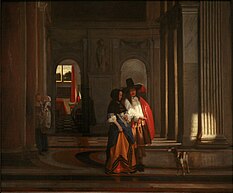
In the 1660s, he began to paint for wealthier patrons in Amsterdam who gained their wealth through increased trade and stock exchanges in a time of unrivalled prosperity, coinciding with de Hooch's premier works, during his Delft-Amsterdam transition. During this period, he was known for upscale merry company scenes and family portraits in opulent interiors with marble floors and high ceilings. During his time in Amsterdam, he continued to make his domestic scenes, but both the interiors and their occupants appear more opulent. With the change in setting, his art evolved to feature cooler colours, more substantial figures, and a technique marked by greater precision. Lacking entrée to the homes of the aristocracy, de Hooch conceived the idea of utilising the newly-built City Hall as a background for his social scenes, a marble-covered setting once considered the eighth wonder of the world. He was thus enabled to paint accurate architectural settings, and the interiors, and to some extent, the light and colour schemes in these paintings are extremely successful. The reference of these public buildings is likely accountable for the overrepresentation of wealth in Dutch households. These works are often associated with the Leidse Fijnschilders, notable for their meticulously detailed paintings, which commanded very high prices. Though, the price of de Hooch's works did not garner the same prices as the Fijnschilders' until the early nineteenth century, when interest in his works increased, as English collectors, including George IV, Sir Robert Peel, and the Duke of Wellington acquired works by de Hooch. Before this period, his paintings commanded a smaller price than that of Vermeer's, and only a fraction of that of Dou's or van Mieris'.

De Hooch also portrayed courting couples engaged in skittle playing, with the finest example on display at Waddesdon Manor. This piece was created shortly after his move to Amsterdam and exemplifies his shift from simple Delft courtyards to the depiction of early country house gardens. The skittle-playing theme connects to the imagery of the "Garden of Love" and "Game of Love" found in both high art and popular print culture. The woman gazing out at the viewer serves as the central figure in this playful "Sport of Love."
Late Period in Amsterdam 1670-1683
Many scholars assert that Pieter de Hooch's work from around 1670 onwards became more stylised and diminished in quality, with some describing him as having "quickly lost his inspiration and charm." However, these assessments are frequently critiqued for applying the aesthetic standards of his earlier Delft paintings rather than considering the evolving artistic norms of post-1670 Dutch art, and the disastrous Rampjaar of 1672 which similarly claimed other contemporary careers . This included time-renowned masters such as Jan Steen, who applied for a licence to run a tavern in the wake of economic downturn.

It is possible that de Hooch's work was influenced by personal distress, following the death of his wife in 1667 at the age of 38, which left him to care for a young family. During his Amsterdam period, de Hooch encountered less success when revisiting motifs from his Delft era, such as depictions involving a young mother with her child and a serving maid, or when he revisited the soldier scenes reminiscent of his earlier days. Though facing minor success with reinterpretations of his Delft period, these instances of self-repetition are devoid of fresh impressions. The paintings are perceived as having an exaggeratedly dark overall tone, and certain prominent colours, notably a sullen vermillion and a cold blue prevalent in the shadows, characterised as harsh. Remarkably, nearly 50% of de Hooch's works date to the last 15 years of his activity, likely to compensate for lower compensation in the wake of the Rampjaar. Additionally, these works are described as appearing lifeless and cumbersome in outline, with a perceived falseness in their structural composition. An anonymous writer in The Connoisseur quoted remarks on late de Hooch, writing, " sacrifices his individuality to the taste of the time."
Upon the acquisition of A Musical Party in a Courtyard by the National Gallery, London in 1916, a debate was provoked in the House of Commons, and the Gallery's Board of Trustees was censored. Writers for The Connoisseur and The Burlington Magazine expressed strong criticism of the artwork, describing the purchase as "an act of folly on the part of the Trustees" and declaring, "Not to mince matters, it is a poor picture, a work of the painter's late and bad period," respectively.
Legacy
Pieter de Hooch's influence persisted under the misnomer of the "De Hooch School." Although there are no records of him having formal students, his work resonated with numerous artists, including van der Burgh and Pieter Janssens Elinga, the latter of whom likely based his painting Woman with a Pearl Necklace on de Hooch’s style, with many of his other works reflecting de Hooch’s Delft period. Emmanuel de Witte is also said to have been influenced by his younger colleague.
The artistic relationship between de Hooch and Ludolf de Jongh remains speculative, as de Jongh was a generation older than de Hooch. Nevertheless, it seems they had a mutual influence on each other. While de Jongh drew inspiration from de Hooch’s later depictions of courtyards and gardens, de Hooch may have been inspired by de Jongh in developing the Koortegardjes genre. Some have theorised a triangular artistic relationship between de Hooch, de Jongh, and Jacob Ochtervelt, all native Rotterdammers, evidenced by their distinctive approaches to soldier paintings.
De Hooch’s legacy enjoyed a resurgence in the 18th century, as admiration for his work grew. Cornelis Troost, for instance, owned one of his paintings and created portraits in line with de Hooch's Delft period style. Artists such as Abraham Van Strij, Jan Ekels, and Wybrand Hendrick also drew inspiration from this period. Numerous 18th-century drawings after de Hooch’s works exist, created by artists like Frans Decker, Cornelis van Noorde, Aart Schouman, Hermanus Numan, and Reinier Vinkeles. His legacy continued to thrive into the 19th century with the formalisation of art evaluation methods, as critic Théophile Thoré-Bürger praised de Hooch in his Salon reviews. This led artists like Jean-François Millet to take a profound interest in his work. As a result, the value of de Hooch’s paintings soared, and some works by other Dutch Golden Age artists, such as Vermeer’s The Art of Painting, were falsely attributed to de Hooch in order to increase their market price. Marcel Proust also admired de Hooch’s interiors, referencing them in Swann's Way to evoke the protagonist's feelings of love. During the 20th century, several works thought to be de Hooch originals were revealed as forgeries, after an unfinished "de Hooch" painting was discovered in Han van Meegeren's studio in 1945.
Art historian Peter C. Sutton argues that de Hooch's later works are largely responsible for the diminished appreciation of his art, advocating that his body of work should be judged without the bias of his weaker, later canvases.
Gallery
For a complete list of paintings attributed to de Hooch, see list of paintings by Pieter de Hooch.-
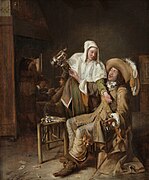 The Empty Glass c. 1652
The Empty Glass c. 1652
-
 Bringer of Bad News c. 1655
Bringer of Bad News c. 1655
-
 A Woman and Child in a Bleaching Ground c. 1657 – c. 1659
A Woman and Child in a Bleaching Ground c. 1657 – c. 1659
-
 The Visit c. 1657
The Visit c. 1657
-
 The Golf Players c. 1658
The Golf Players c. 1658
-
 Cardplayers in a Sunlit Room c. 1658
Cardplayers in a Sunlit Room c. 1658
-
 A Dutch Courtyard c. 1658 – c. 1660
A Dutch Courtyard c. 1658 – c. 1660
-
 Group portrait of an unknown family or company c. 1650 – c. 1665
Group portrait of an unknown family or company c. 1650 – c. 1665
-
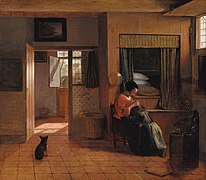 A Mother's Duty c. 1658
A Mother's Duty c. 1658
-
 The Courtyard of a House in Delft c. 1658
The Courtyard of a House in Delft c. 1658
-
 Company in a courtyard behind a house c. 1663
Company in a courtyard behind a house c. 1663
-
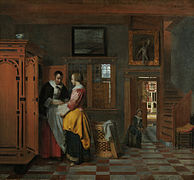 Two Women Beside a Linen Chest, with a Child c. 1663
Two Women Beside a Linen Chest, with a Child c. 1663
-
 The Maidservant c. 1667
The Maidservant c. 1667
-
 Man Reading a Letter and a Woman Sewing c. 1674 – c. 1676
Man Reading a Letter and a Woman Sewing c. 1674 – c. 1676
-
 Company in an interior eating oysters c. 1681
Company in an interior eating oysters c. 1681
See also
References
- ^ "Artist Info". www.nga.gov. Retrieved 27 October 2023.
- ^ "RKD Research". research.rkd.nl. Retrieved 15 May 2024.
- Grijzenhout 2008, pp. 612–613.
- Sutton 1998, p. 14.
- Houbraken 1753, p. 34.
- "Vermeer's Delft Today: the House of Pieter de Hooch". www.essentialvermeer.com. Retrieved 26 June 2024.
- "Transcendence in Ordinary Domestic Life", Wall Street Journal, 19 August 2017
- According to biographer Peter C. Sutton, De Hooch's wife Jannetje van der Burch was family of Hendrick van der Burgh (ca. 1625– na 1664) who lived in Leiden, also on the Delft-Amsterdam trekschuit route
- ^ Sutton 1998, p. 15.
- ^ Sutton 1998, p. 58.
- Rijksmuseum press release, 19 April 2018
- Franits 2006, p. 13.
- ^ Pieter de Hooch (1 January 1930). Pieter de Hooch;: The master's paintings in 180 reproductions, with an appendix on the genre painters in the manner of Pieter de Hooch and Hendrik van der Burch's art. Internet Archive. A. Zwemmer.
- "Pieter de Hooch - Artists - Rijksstudio".
- Franits 1989, pp. 559–566.
- "Pieter de Hooch | Dutch painter | Britannica". www.britannica.com. Retrieved 11 December 2021.
- Franits 2006, pp. 13–14.
- "Woman Holding a Balance". www.nga.gov. Retrieved 10 March 2024.
- "Seven Dutch Masters: Pieter de Hooch". www.essentialvermeer.com. Retrieved 19 July 2024.
- "The School of Delft: Pieter de Hooch and Johannes Vermeer". www.essentialvermeer.com. Retrieved 8 August 2024.
- "Vermeer's Signatures". www.essentialvermeer.com. Retrieved 8 August 2024.
- Sutton 1998, p. 26.
- Sutton 1998, p. 32.
- Franits 2006, p. 16.
- Franits 2006, p. 65.
- "Witte, Emanuel de. Museo Nacional Thyssen-Bornemisza". www.museothyssen.org. Retrieved 5 June 2024.
- "Artist Info". www.nga.gov. Retrieved 5 June 2024.
- Hollander, Martha (2000). "Public and private life in the art of Pieter de Hooch". Nederlands Kunsthistorisch Jaarboek (NKJ) / Netherlands Yearbook for History of Art. 51: 272–293. ISSN 0169-6726.
- Franits 2006, pp. 22–26.
- Franits 2006, p. 61, 66.
- ^ Franits 2006, p. 24.
- Sutton 1998, p. 56.
- "Amsterdam Heritage: Town hall in the Dam Square (1648/65), now Royal Palace". Municipal Department for Preservation and Restoration of Historic Buildings and Sites of Amsterdam. Archived from the original on 5 May 2006.
- ^ Franits 2006, p. 67.
- Sutton 1980, pp. 54–55.
- Sutton 1980, p. 35.
- Munt, Annette (1997). "The Impact of the Rampjaar on Dutch Golden Age Culture". Dutch Crossing. 21 (1): 3–51. doi:10.1080/03096564.1997.11784072. ISSN 0309-6564.
- Franits 2006, p. 33.
- Houbraken 1753, p. 35.
- Sutton 1980, p. 72, note. 42.
- ^ Sutton 1998, p. 81.
- Sutton 1998, p. 87.
- ^ Sutton 1998, p. 78.
- Fleischer 1978.
- Fleischer, R. E. (1978). "Ludolf de Jongh and the Early Work of Pieter de Hooch". Oud Holland. 92 (1): 49–67. ISSN 0030-672X.
- ^ Sutton 1998, p. 80.
Sources
- Franits, Wayne E. (1989). "The Depiction of Servants in Some Paintings by Pieter de Hooch". Zeitschrift für Kunstgeschichte. 52 (4): 559–566. doi:10.2307/1482471. ISSN 0044-2992. JSTOR 1482471 – via JSTOR.
- Franits, Wayne E. (2006). Pieter de Hooch: A woman preparing bread and butter for a boy. Los Angeles: J. Paul Getty Museum. pp. 13–67. ISBN 978-0-89236-844-0.
- Grijzenhout, Frans (2008). "New Information on Pieter de Hooch and the Amsterdam Lunatic Asylum". The Burlington Magazine. 150 (1266): 612–613. ISSN 0007-6287. JSTOR 40479869.
- Houbraken, Arnold (1753). "[Pieter de Hooge], De groote schouburgh der Nederlantsche konstschilders en schilderessen". DBNL (in Dutch). Retrieved 21 September 2024.
- Sutton, Peter C. (1980). Pieter de Hooch. Ithaca, N.Y.: Cornell University Press. ISBN 0801413397 – via Internet Archive.
- Sutton, Peter C. (1998). Pieter de Hooch, 1629–1684. Hartford, Conn.; New Haven: Dulwich Picture Gallery, Wadsworth Atheneum: In association with Yale University Press. ISBN 0300077572 – via Internet Archive.
External links
- A Game of Ninepins at Waddesdon Manor
- From Dou to De Hooch blog article, Waddesdon Manor
- "Pieter de Hooch online"
- Works and literature on Pieter de Hooch
- "Pieter de Hooch" . Encyclopædia Britannica. Vol. XII (9th ed.). 1881. p. 144.
- Vermeer and The Delft School, exhibition catalog from The Metropolitan Museum of Art (fully available online as PDF)
- The Milkmaid by Johannes Vermeer, exhibition catalog from The Metropolitan Museum of Art (fully available online as PDF)
- Fifteenth- to eighteenth-century European paintings: France, Central Europe, the Netherlands, Spain, and Great Britain, collection catalog from The Metropolitan Museum of Art (fully available online as a PDF)
- 19 artworks by or after Pieter de Hooch at the Art UK site